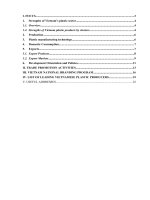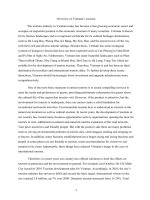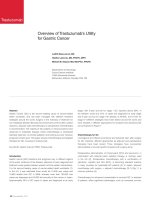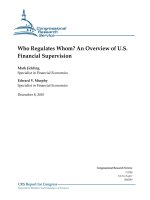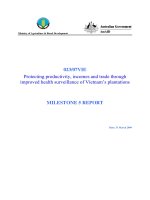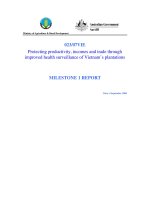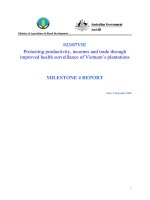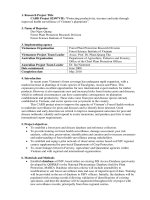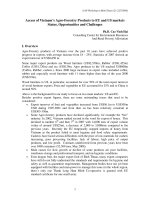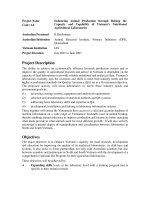Overview of Vietnam’s tourism
Bạn đang xem bản rút gọn của tài liệu. Xem và tải ngay bản đầy đủ của tài liệu tại đây (62.68 KB, 8 trang )
Overview of Vietnam’s tourism
The tourism industry in Vietnam today has become a fast-growing economic sector and
occupies an important position in the economic structure of many countries. Vietnam is known
for its famous landscapes and is recognized worldwide for its cultural heritages destinations such
as Ha Long Bay, Phong Nha, Ke Bang, My Son, Hue, and the ancient town of Hoi An, with their
rich and diverse natural settings. Besides those, Vietnam has some ecological systems of
mangrove forests that have not been exploited such as Cuc Phuong in Ninh Binh and Pu Mat in
Nghe An. Furthermore, Vietnam has many beautiful landscapes such as Phan Thiet in
Binh Thuan, Nha Trang in Khanh Hoa, Bai Chay in Ha Long, Vung Tau which are suitable for
the development of marine tourism. Therefore, Vietnam is and has been an ideal destination for
travellers and international tourists alike. To further develop these scenic attractions, Vietnam
should increasingly boost investment and upgrade infrastructure more comprehensively.
One of the most basic measures to attract tourists is to create compelling services to meet
the needs and preferences of guests, providing preliminary information for guests about the
cultural life of the region that tourists visit. However, if the product is attractive, but the
environment for tourists is inadequate, then you cannot create a solid foundation for recreational
and tourist activities. Environmental tourism here is understood as tourism in the natural
environment as well as cultural tourism. In recent years, the development of tourism in our
country has created many business opportunities such as organizations opening the door for
tourists to visit, additional investment and materials and the expansion of the road network, Tour
price incentives and friendly people. But with the positive side there are many problems such as
solving environmental pollution at tourist sites, some beggars stealing and clinging on to buyers.
In addition, many business establishments have begun dying and losing business and people in
some places are not friendly to tourists, some accommodation for visitors to rest remains to be
clean. Importantly, these things have reduced Vietnam's image in the eyes of international
tourists.
Therefore, in recent years our country has offered solutions to limit the effects on
tourism in particular and the environment in general. For example, last October, Ho Chi Minh
City issued its 2010 Tourism development plan for Vietnam. Accordingly, in 2010, the city’s
tourism industry has striven to fulfil and exceed the basic target. International visitors to the city
reached 2.8 million, up 7% over 2009. Domestic tourists increased form 15-20%. Total revenue
reached VND 40,000 billion, an increase of 15% over 2009’s revenue. As a result, it reinforces
1
the important role of tourism in Ho Chi Minh City as well as it affirms the development of “the
Vietnam’s tourism of the new millennium.”
Advantages of tourism development in Vietnam
As we know to develop tourism in Vietnam successfully, the most crucial factor is to
provide a pristine natural environment because this is the key to ensure lasting impressions and
therefore satisfied customers. Also, when talking about the environment, by definition we mean
both the natural and material elements, so creating a close inter-connected relationship of these
aspects is equally important. As tourism grows, there should be little or no impact on the
environment otherwise gradually its natural beauty will be destroyed. Tourism is becoming an
increasingly popular sector and it is rapidly developing all over the world, so when people exploit
tourist resources, they need to pay particular attention to its environmental impact in the long
term.
According to Vietnam footprints issued on April 23rd, 2006 (Source: ND) “In the first
quarter of 2006, Vietnam has attracted more than one million international tourists, Vietnam is
frequently viewed as a friendly and safe destination and ranked as one of the most attractive
destinations in the world over the next decade. Vietnamese tourism has gradually affirmed its
role as a leading economic power.” accordingly we know that “After the 1997 regional economic
crisis, despite being affected by pandemics, natural disasters and conflicts in regions of the
world, the Vietnamese tourism industry is entering a strong development period. Over the past 15
years, the number of tourists has increased by 20% each year on average. The number of
international tourists to Vietnam has increased 11 fold, from 250,000 in 1990 to 3.4 million in
2005. The tourism industry has earned more than VND 30 billion, exceeding the plan”. Because
of these economic and social achievements, this has contributed to the alleviation of poverty,
improving living standards and social enrichment therefore the development of tourism has
helped change the face of urban and rural areas.
The tourism industry has created an ability to consume goods and services higher and as a
result it has boosted the development of other industries such as the restoration of many
traditional festivals and craft villages, facilitated the economic restructuring of the whole country
and each locality, expanded exchanges among regions and with foreign countries, and ensured
the security, national defence and social order of the country. Through tourism, there are many
historical and cultural places have been preserved.
2
According to the Vietnam footprints has also said that “Directed by the government, the
tourism industry has co-ordinated with relevant ministries and bodies and localities to build and
complete major mechanisms and policies on tourism such as the Tourism Ordinance, Tourism
Law and National Action Plan on tourism. This law took effect in January 2006 and is the most
important legal document that sets outs a framework for tourist activities.
So far, there have been more than 6,000 institutions that operate in the accommodation
business nationwide with more than 130,000 rooms, including 18 five-star hotels, 48 four-star
hotels and 300 international tourist companies. Hanoi, Ho Chi Minh City, Quang Ninh, Da Nang
and Hai phong have the most international tourist companies.
Re-organisation and renovation of state-owned travel businesses have been improved and
the government has funded VND 2,146 billion to help improve tourism infrastructure in key
tourism centres with 358 projects in 58 provinces and centrally-run cities. The tourism industry
has also attracted 190 direct foreign investment projects with a total registered capital of US
$4.64 billion in 29 provinces and cities. Vietnam has exempted visas for citizens from Japan, the
Republic of Korea and some Nordic countries. Visas granting has been diversified, for example,
visas are granted to tourists at Vietnamese embassies abroad, and at international border gates for
those who stay in Vietnam up to a maximum of 15 days.”
Infrastructure is one of the most important factors in the growth of the tourism industry in
the recent period, the tourism industry has focused more organized tourist destination, the resorts,
the trip by sea, river, besides, also organized many tours such as hiking, diving, cave tour and
travel across Vietnam by motorcycle, car and bicycle. In recent years, Vietnam has attracted
thousands of international tourists travelling by sea. With the right promotion and problem
solving strategies, the tourism sector and localities have organised many travel events
successfully in Ha Long, Nghe An and Quang Nam, along with festivals throughout the country.
These programmes have made a great contribution to promoting the image of Vietnam tourism to
the world.
In addition, the social republic of Vietnam has significant potential for tourism
development and it is rich in natural and cultural tourism resources. A master plan for the
development of tourism for Vietnam was published by the world tourism organisation in
collaboration with a United Nations Development plan. The government has recognized the
importance of the development of tourism by marking it a priority industry for national
development. This has involved preparing a new master plan focusing on infrastructure
3
requirements, education, and the marketing of tourism. Vietnam has certain advantages as an
international tourism destination through its central geographical location in Southeast Asia and
its ability to cater to tourists all year round. One of the new tourism concepts proposed is
“Vietnam by train”. This will disperse tourism over many regions of the country with minimal
environmental impact and low infrastructure costs. A future proposal is to build rail links with
China and Cambodia. Tourism development is being concentrated in and around four main
economic zones. Northern Vietnam is to be developed as the staging area for excursion to Ha
Long Bay, with its famous scenery, beaches, and ocean for cruising. The southern part of the
central zone has greater potential for ecotourism. There is an abundance of natural resources
favouring coastal resort developments and consequent nature-based activities in the terrestrial
and marine environments. The preservation of the environment is identified as a key issue for this
area. For example, there is a need to prevent forest destruction, the population of the Perfume
River (which flows through Hue) and the Han River (which flows through Da nang), and in
general the population of water, air, and the coastline. Southern Vietnam will particularly foster
ecotourism based on the central node the Ho Chi Minh City. It appears that the Vietnamese
government is committed to developing tourism along sustainable guidelines. However, the
achievement of this development will be difficult in light of the urgent need for Vietnam to earn
foreign exchange and because of its limited resources and knowledge. The issues of sustainability
therefore hinges on the political will of the government and the ability of the tourism sector to
learn from other countries in the region, which have developed sustainable types of tourism.
Disadvantages of tourism development in Vietnam
Because of the growing science, the introduction of machinery has caused environmental
pollution and degradation to the ecosystem as well as raising atmospheric temperatures. Because
of this, traveling has become increasingly difficult and has lost its beauty. Vietnam faces a
number of challengers as a popular tourist destination. Some of these difficulties include a
number of constraints hindering Vietnam’s tourism development such as poor infrastructure,
graft, the lack of appropriate accommodation facilities of international standards, and inadequate
skilled workers and qualified management people. The first is the lack of infrastructure. In a
sense, for mainstream tourism to flourish in a country, the means to develop tourism must first be
in place at the same time. This means a country must have good roads, a well-develop
transportation system, well- staffed tourism companies, and quality hotels. Vietnam’s railroad
system is very primitive and many trains are not able travel at more than twenty or thirty miles
4
per hour. The roads in some places are in very poor condition. However, government officials in
Vietnam are aware of the importance of tourism and now are making rapid progress in
developing its infrastructure and they are also training people to work in the tourism industry.
Vietnam is generally seen as a very poor country and many tourists are afraid that
underdeveloped countries such as Vietnam may restrict tourists finding suitable hotels and that
there are not adequate medical facilities. Moreover, the problem is that the products they are
selling are often very poor quality copies of recognized brands but the selling price is not cheap.
Also there is a chance they will be besieged by beggars or they might face personal risk of
robbery. If this happens, they will not be able to buy things they need and they will encounter
numerous other difficulties, such as flooding after rainstorms.
Disadvantages of tourism in Vietnam
Although achieving the development, there are still difficulties, limited both subjective
and objective. Therefore, they have not led to the development of stable, effective not
commensurate with the tourism potential of the country.
a / Facilities are not synchronized and the low quality of products
Until now, we have no recreational facilities in association with the landscapes attractions like
the world in many countries and regions, the number of capital to be mobilized is very large in
this area while the capacity to mobilize capital limited. Besides, funds are also being limited; the
investments are not focus on key. Infrastructure and transport are also poorly, so the
transportation of passengers it also takes a lot of time, influence time to relax, visit ... do not fit
your needs psychological
Vietnam's tourism products is not diversified, the quality of products is not satisfy the
requirements of visitors. Landscapes, environments and value the unique ethnic culture are not
untapped; many opportunities are missed from foreigner.
b/ The International cooperation and promoting marketing are also revealed many shortcomings
The Vietnam’s tourism hasn't initiative in international cooperation; participation in the market
are also spontaneous, do not capture the trend of movement of each type of market.
Promotion of the tourism market has not been interested in the management and inadequate
market, some mechanism, such as equalization policy, management was slow when
5
